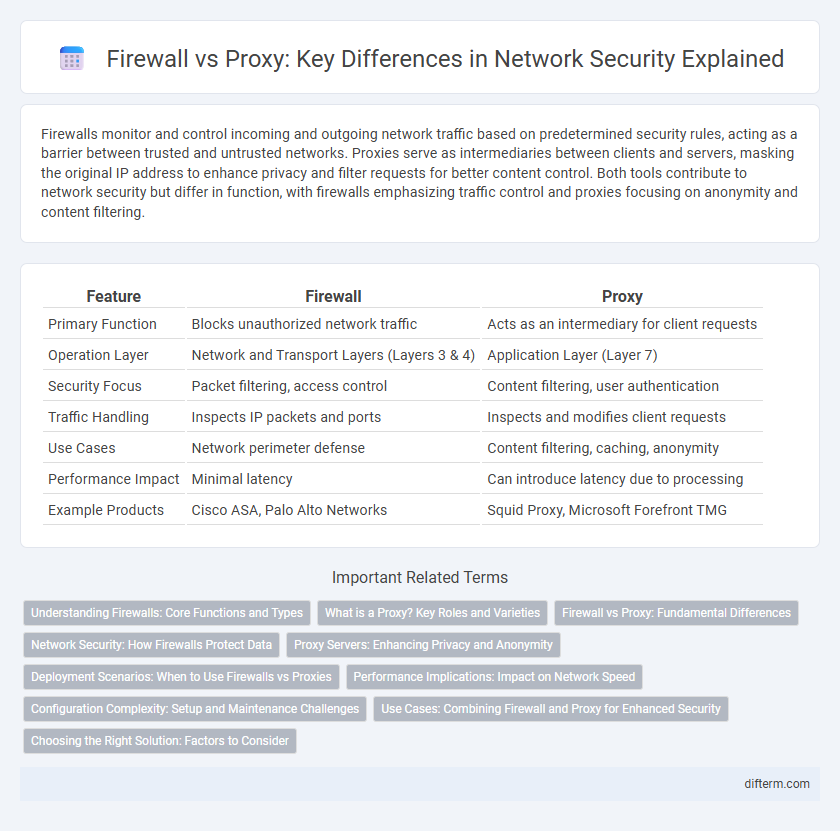Firewalls monitor and control incoming and outgoing network traffic based on predetermined security rules, acting as a barrier between trusted and untrusted networks. Proxies serve as intermediaries between clients and servers, masking the original IP address to enhance privacy and filter requests for better content control. Both tools contribute to network security but differ in function, with firewalls emphasizing traffic control and proxies focusing on anonymity and content filtering.
Table of Comparison
| Feature | Firewall | Proxy |
|---|---|---|
| Primary Function | Blocks unauthorized network traffic | Acts as an intermediary for client requests |
| Operation Layer | Network and Transport Layers (Layers 3 & 4) | Application Layer (Layer 7) |
| Security Focus | Packet filtering, access control | Content filtering, user authentication |
| Traffic Handling | Inspects IP packets and ports | Inspects and modifies client requests |
| Use Cases | Network perimeter defense | Content filtering, caching, anonymity |
| Performance Impact | Minimal latency | Can introduce latency due to processing |
| Example Products | Cisco ASA, Palo Alto Networks | Squid Proxy, Microsoft Forefront TMG |
Understanding Firewalls: Core Functions and Types
Firewalls serve as critical security barriers that monitor and control incoming and outgoing network traffic based on predetermined security rules. Core firewall types include packet-filtering firewalls, stateful inspection firewalls, and next-generation firewalls (NGFW) that integrate intrusion prevention and application awareness. Understanding these functions and types enables organizations to effectively safeguard networks against unauthorized access, cyber threats, and data breaches.
What is a Proxy? Key Roles and Varieties
A proxy acts as an intermediary between a user's device and the internet, enhancing security by filtering requests and masking IP addresses to prevent direct exposure to external threats. It performs key roles such as content filtering, user authentication, and caching to improve performance and protect sensitive data. Common varieties include forward proxies for client requests, reverse proxies for server protection, and transparent proxies that require no configuration on the user's device.
Firewall vs Proxy: Fundamental Differences
Firewalls act as a barrier between trusted internal networks and untrusted external networks, monitoring and controlling incoming and outgoing traffic based on predetermined security rules. Proxies function as intermediaries that handle requests from clients seeking resources from other servers, often providing anonymity and content filtering. While firewalls primarily enforce network-level security by filtering traffic, proxies operate at the application layer, managing user access and caching content to enhance performance.
Network Security: How Firewalls Protect Data
Firewalls act as a critical barrier between trusted internal networks and untrusted external networks, filtering incoming and outgoing traffic based on predefined security rules to prevent unauthorized access and data breaches. By inspecting packets at multiple layers, including IP addresses, ports, and protocols, firewalls effectively block malicious activities like intrusions, malware, and denial-of-service attacks. Unlike proxies that primarily manage data requests, firewalls deliver robust network security by enforcing strict policies that safeguard sensitive information from cyber threats.
Proxy Servers: Enhancing Privacy and Anonymity
Proxy servers act as intermediaries between users and the internet, masking IP addresses to enhance privacy and anonymity during online activities. They filter requests, block malicious content, and prevent direct access to user devices, thereby reducing exposure to cyber threats. By encrypting web traffic and managing access controls, proxy servers provide a robust layer of security that complements traditional firewall defenses.
Deployment Scenarios: When to Use Firewalls vs Proxies
Firewalls are essential for network perimeter defense, filtering traffic based on IP addresses, ports, and protocols to block unauthorized access and ensure secure network boundaries. Proxies are ideal for content filtering, user authentication, and monitoring web traffic within internal networks, providing granular control over user requests and data flow. Deploy firewalls when protecting entire network segments from external threats, and use proxies to manage, cache, and inspect specific application-layer traffic for enhanced security and performance.
Performance Implications: Impact on Network Speed
Firewalls inspect and filter traffic at the packet level, which can introduce latency but generally maintain stable network speeds due to hardware acceleration and optimized rulesets. Proxies, acting as intermediaries for client requests, may cause more noticeable delays by processing and caching content, especially under heavy loads or complex filtering. Network administrators must balance security policies with resource allocation to minimize performance degradation and ensure optimal throughput.
Configuration Complexity: Setup and Maintenance Challenges
Firewall configuration involves detailed rule-setting for network traffic filtering, requiring expertise to balance security with usability, while proxies demand intricate setup for traffic interception and caching. Maintenance of firewalls often includes frequent updates to rule sets and monitoring for unauthorized changes, whereas proxies require ongoing management of access controls and content filtering policies. Both firewall and proxy configurations pose challenges; however, firewalls generally demand more granular control, increasing complexity in setup and long-term management.
Use Cases: Combining Firewall and Proxy for Enhanced Security
Combining a firewall and proxy server enhances network security by leveraging the firewall's ability to filter traffic based on IP addresses, ports, and protocols alongside the proxy's capacity to manage and monitor user requests at the application layer. Firewalls provide perimeter defense and block unauthorized access, while proxies enforce content filtering, user authentication, and caching to optimize traffic and prevent malware infiltration. Integrating these technologies creates a layered security approach that improves threat detection, controls outbound data flow, and ensures comprehensive policy enforcement across the network.
Choosing the Right Solution: Factors to Consider
Choosing between a firewall and a proxy depends on the specific security needs and network architecture of an organization. Firewalls offer robust protection by monitoring and controlling incoming and outgoing network traffic based on predetermined security rules, while proxies provide anonymity and control over user access to web content by acting as intermediaries. Factors such as desired level of traffic inspection, performance impact, application control, and compliance requirements should guide the decision to implement either technology.
Firewall vs Proxy Infographic

 difterm.com
difterm.com